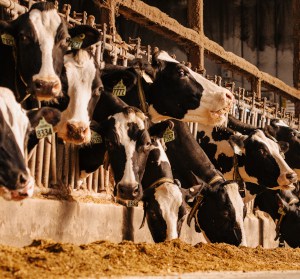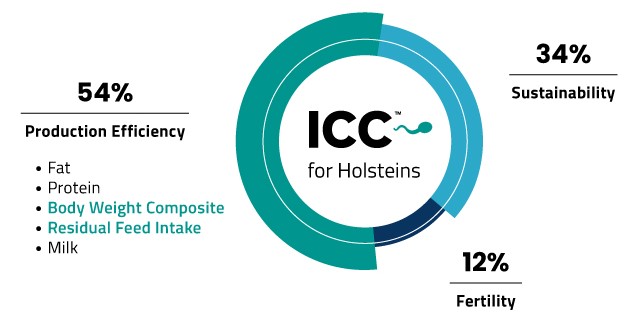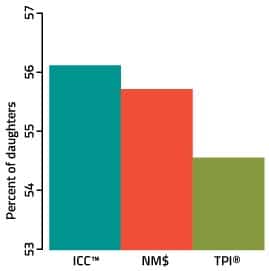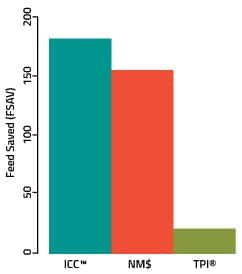Truth
Feed costs are some of the highest inputs on a farm.
Myth
You can’t genetically select for feed efficiency.
Truth
You have access to the best tool to genetically select for feed efficiency and production.
When it comes to selection for dairy cattle feed efficiency, GENEX ICC™ has you covered.
Because EFFICIENCY MATTERS!
As a dairy producer, you know efficiency is key to your profitability. Efficiency is important throughout all parts of your business and its daily operations. It’s even more important when it impacts the biggest line item on your expense sheet: feed costs!
We have entered an exciting era in the dairy industry where we now have the power to select for feed efficiency through genetics. This is unprecedented and exciting territory for dairy producers.

Why is feed efficiency so important?
- Feed costs can make up over half of the total cost on a dairy farm.1
- Improving the efficiency of dairy cows will help reduce the amount of natural resources and energy needed to produce and process the feed required.
- Several studies have shown cows that are more feed efficient also produce lower methane emissions.2,3
- Genetic selection for feed efficiency supports industry goals to reduce the environmental footprint of dairy production.
With ICC™ selection, you get feed efficiency!
Because of the enormous impact that feed costs have on your operation’s bottom-line, we prioritized feed efficiency in our GENEX selection index and bull lineup.
In April 2021, we updated ICC™ by adding Residual Feed Intake and Body Weight Composite. It’s these two traits that together comprise the industry’s new Feed Saved trait. The update to ICC™ made this selection index the industry leader in creating the next generation of feed-efficient animals.

Can I get both production and feed efficiency?
ICC™ provides balanced genetic progress for your herd. So, YES, the data shows you can get both production and feed efficiency through ICC™ selection.
We compared the milk production records of 400,000+ daughters of top-ranking bulls for three indexes (TPI®, NM$ and ICC™). Based on these production records, which covered a 4-year period, daughters of high-ranking ICC™ sires outperformed daughters of high-ranking sires from the other indexes! In addition, as Graph 1 shows, a larger percentage of daughters of elite ICC™ sires reached 50,000 lbs (22,680 kgs) of milk by 300 weeks of age.
Graph 1. Percent of daughters to
produce 50k lbs Milk by 300 weeks

Production + Feed Efficiency = Big Impact
In the analysis, daughters of high-ranking ICC™ bulls excelled in production, but what about feed efficiency? ICC™ offers a MAJOR ADVANTAGE in feed efficiency, which can benefit your bottom-line.
Graph 2 shows the Feed Saved (FSAV) weighted average of the sires for those same 400,000+ cows. Based on the bulls’ FSAV values, the daughters of high-ranking ICC™ sires are expected to have consumed about 100 pounds less dry matter per lactation compared to daughters of high-ranking NM$ sires and about 165 pounds less than daughters of high TPI® sires!
Graph 2. Weighted average
FSAV for top bulls

What does FSAV mean?
Feed Saved (FSAV) represents the expected pounds of feed saved per cow per lactation based on Body Weight Composite and Residual Feed Intake. Larger, positive values are more favorable.
Not only does genetic selection for feed efficiency through ICC™ support your bottom-line, but it also supports industry goals to reduce the environmental footprint of dairy production!
¹ United States Department of Agriculture – Economic Research Service. 2018. Milk cost of production estimates. http://www.ers.usda.gov/data-products/milk-cost-of-production-estimates/.
² de Haas Y, Windig JJ, Calus MPL, Dijkstra J, de Haan M, Bannink A and Veerkamp RF. 2011. Genetic parameters for predicted methane production and potential for reducing enteric emissions through genomic selection. J. Dairy Sci. 94, 6122-6134.
³ Waghorn GC and Hegarty Rs. 2011. Lowering ruminant methane emissions through improved feed conversion efficiency. Animal Feed Science and Technology 166, 291-301. Doi:10.1016/j.anifeedsci.2011.04.019


